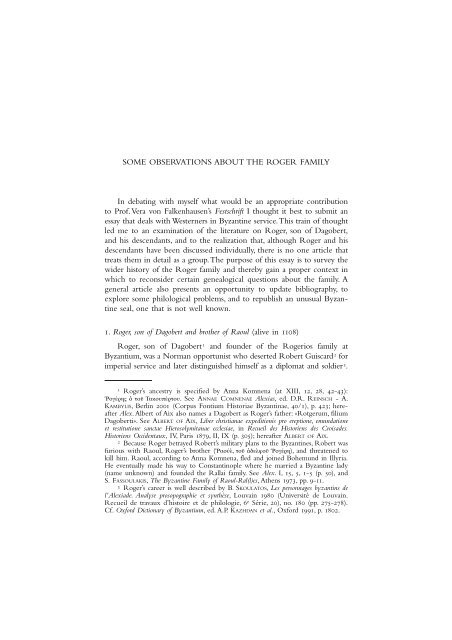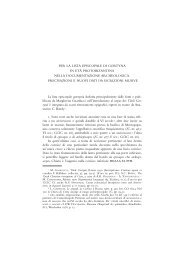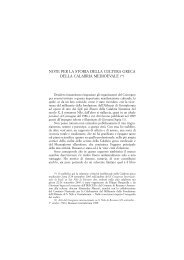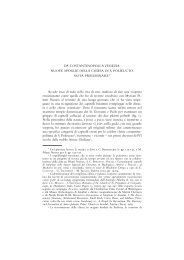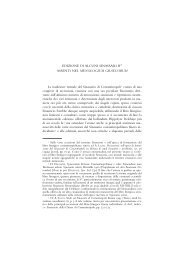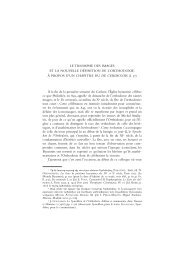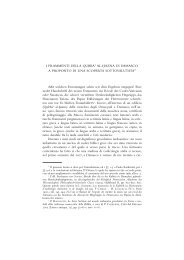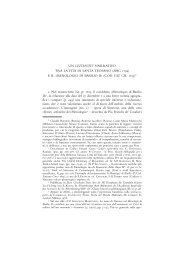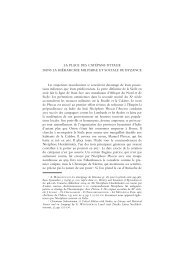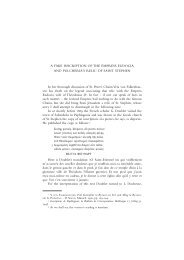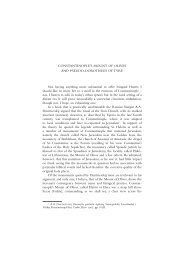John Nesbitt
John Nesbitt
John Nesbitt
You also want an ePaper? Increase the reach of your titles
YUMPU automatically turns print PDFs into web optimized ePapers that Google loves.
SOME OBSERVATIONS ABOUT THE ROGER FAMILY<br />
209<br />
In debating with myself what would be an appropriate contribution<br />
to Prof.Vera von Falkenhausen’s Festschrift I thought it best to submit an<br />
essay that deals with Westerners in Byzantine service.This train of thought<br />
led me to an examination of the literature on Roger, son of Dagobert,<br />
and his descendants, and to the realization that, although Roger and his<br />
descendants have been discussed individually, there is no one article that<br />
treats them in detail as a group.The purpose of this essay is to survey the<br />
wider history of the Roger family and thereby gain a proper context in<br />
which to reconsider certain genealogical questions about the family. A<br />
general article also presents an opportunity to update bibliography, to<br />
explore some philological problems, and to republish an unusual Byzantine<br />
seal, one that is not well known.<br />
1. Roger, son of Dagobert and brother of Raoul (alive in 1108)<br />
Roger, son of Dagobert 1 and founder of the Rogerios family at<br />
Byzantium, was a Norman opportunist who deserted Robert Guiscard 2 for<br />
imperial service and later distinguished himself as a diplomat and soldier 3 .<br />
1 Roger’s ancestry is specified by Anna Komnena (at XIII, 12, 28, 42-43):<br />
Ργέρης τ Τακυπέρτυ. See ANNAE COMNENAE Alexias, ed. D.R. REINSCH - A.<br />
KAMBYLIS, Berlin 2001 (Corpus Fontium Historiae Byzantinae, 40/1), p. 423; hereafter<br />
Alex. Albert of Aix also names a Dagobert as Roger’s father: «Rotgerum, filium<br />
Dagoberti». See ALBERT OF AIX, Liber christianae expeditionis pro ereptione, emundatione<br />
et restitutione sanctae Hierosolymitanae ecclesiae, in Recueil des Historiens des Croisades.<br />
Historiens Occidentaux, IV, Paris 1879, II, IX (p. 305); hereafter ALBERT OF AIX.<br />
2 Because Roger betrayed Robert’s military plans to the Byzantines, Robert was<br />
furious with Raoul, Roger’s brother (Ραλ, τ δελ Ργέρη), and threatened to<br />
kill him. Raoul, according to Anna Komnena, fled and joined Bohemund in Illyria.<br />
He eventually made his way to Constantinople where he married a Byzantine lady<br />
(name unknown) and founded the Rallai family. See Alex. I,15, 5, 1-5 (p. 50), and<br />
S. FASSOULAKIS, The Byzantine Family of Raoul-Ral(l)es, Athens 1973, pp.9-11.<br />
3 Roger’s career is well described by B. SKOULATOS, Les personnages byzantins de<br />
l’Alexiade. Analyse prosopographie et synthèse, Louvain 1980 (Université de Louvain.<br />
Recueil de travaux d’histoire et de philologie, 6 e Série, 20), no. 180 (pp. 275-278).<br />
Cf. Oxford Dictionary of Byzantium, ed. A.P. KAZHDAN et al., Oxford 1991, p.1802.
210<br />
JOHN NESBITT<br />
About 1079 Robert Guiscard had sent from Salerno Roger’s brother,<br />
Raoul, to Constantinople to inform Emperor Nikephoros III that he was<br />
aggrieved by the emperor’s usurpation of power and his decision to disallow<br />
the marriage of his predecessor’s son, Constantine Doukas, to Robert’s<br />
daughter, Helena. Robert hoped to use this situation as an excuse for war.<br />
When Raoul rejoined Guiscard’s court, this time at Brindisi, where the<br />
duke of Apulia and Calabria was assembling an invasion force, he informed<br />
his master that Alexios Komnenos had assumed the imperial mantle and<br />
had elected to grant Constantine Doukas a share in the empire’s governance.<br />
Hence Guiscard had no legal basis for attacking Byzantium. At this<br />
juncture Raoul’s brother, Roger, decided to leave Brindisi and to betray<br />
Robert’s pre-emptive strike against Byzantine territory to imperial authorities.We<br />
next hear of Roger some fifteen years later. In 1096 Alexios Komnenos<br />
sent Roger and Rudolfus Pel-de-Leu to negotiate with Godfrey<br />
of Bouillon, duke of Lower Lorraine, regarding the passage of crusaders<br />
through Byzantine lands and their conduct 4 . In 1108, Alexios consulted<br />
with Roger, the sebastos Marinos of Naples and Peter of Aulps, regarding a<br />
plan to sow dissension among Bohemund’s forces 5 . Afterwards Alexios<br />
sent Roger to Bohemund as a hostage, along with Marinos of Naples,<br />
Adralestos and Constantine Euphorbenos 6 . His name appears among the<br />
signatories of the peace treaty of September, 1108 7 . At some point in his<br />
career he received the title of sebastos. For upon his death Kallikles composed<br />
an epitaph entitled ες τν τάν Ργερίυ τ σεαστ 8 . The poet<br />
alludes to Roger’s earlier exploits in Italy 9 and intimates that Roger participated<br />
in expeditions against the Pechenegs and Turks («the Celts and<br />
the Istrian Scyths and the sons of the Persians shout my brave deeds») 10 .<br />
4 ALBERT OF AIX, II, IX (p. 305). The crusaders were proceeding from Adrianople<br />
to the capital and on the way were robbing Byzantine citizens and destroying<br />
property.<br />
5 Alex., XIII, 4, 4 (p. 395).<br />
6 Alex., XIII, 9, 1 (pp. 407-408).<br />
7 Alex., XIII, 12, 28, 42-43 (p. 423).<br />
8 NICOLA CALLICLE, Carmi. Testo critico, introduzione, traduzione, commentario e<br />
lessico, ed. R. ROMANO, Naples 1980 (Byzantina et neohellenica neapolitana, Collana<br />
di Studi e Testi diretta da Antonio Garzya), no. 19 (pp. 93-95). Specification of his<br />
rank is repeated in line 34 (p. 94) where there is mention of enrollment in the ranks<br />
of the sebastoi (τ τν σεαστν νι πρσεγράην).<br />
9 CALLICLE, Carmi cit., lines 23-29 (p. 94).<br />
10 CALLICLE, Carmi cit., lines 37-39 (p. 94): κα τς µς ντεθεν νδραγαθίας /<br />
Κελτ σιν κα παρίστριι Σκθαι / κα τέκνα Περσν...
SOME OBSERVATIONS ABOUT THE ROGER FAMILY 211<br />
Mention of the Pechenegs suggests that Roger may have participated in<br />
the campaigns against them of 1087 or been present at the battle of Mt.<br />
Lebounion where the Pechenegs sustained a crushing defeat in 1091.<br />
Finally Kallikles indicates that Roger married a prominent lady and that<br />
the union produced offspring («golden sons») 11 .<br />
2. Constantine Roger (dead by 1136)<br />
Constantine Roger, sebastos, is known solely from a reference in the<br />
Pantokrator Typikon (date: October 1136) of Emperor <strong>John</strong> II Komnenos 12 .<br />
The document specifies that, along with others, Constantine Roger, sebastos,<br />
should be remembered on the Saturdays of Meatfare, Cheesefare,<br />
and Pentecost.<br />
3. <strong>John</strong> Roger-Dalassenos (dead after 1166)<br />
In 1144/1145, while Emperor Manuel was having a fort constructed<br />
in the region of Melangia, news reached him that «the eldest daughter of<br />
Emperor <strong>John</strong>, whom Caesar Roger had married, was sick and in danger<br />
of her life»: ς τ πρεσυτάτη τν ασιλέως Ιωάννυ θυγατέρων, ν κασαρ<br />
γάγετ Ργέρις, νσς πιγεγνυα υκτν πγράει τν κίνδυνν 13 .In<br />
the end the lady, named Maria, died. Our informant, the historian <strong>John</strong><br />
Kinnamos, goes on to say that when <strong>John</strong> II died (April, 1143) Roger<br />
(reportedly) had designs on the imperial throne and attracted to his<br />
cause some four hundred adherents, including Prince Robert, the former<br />
governor of Capua, who was then living in the capital. Roger’s wife,<br />
Maria, opposed her husband’s ambitions and unable to dissuade him<br />
exposed the plot to officials loyal to her brother.The conspiracy came to<br />
11 CALLICLE, Carmi cit., lines 35 and 36: κα κδς σν κ µεταρσίυ γένυς / κα<br />
τέκνα ρυσ...<br />
12 P. GAUTIER, Le typikon du Christ Sauveur Pantocrator, in Revue des études byzantines<br />
32 (1974), pp. 44-45: σεαστς κρις Κωνσταντνς Ργέρης.<br />
13 IOANNIS CINNAMI epitome rerum ab Ioanne et Alexio Comnenis gestarum, ed. A.<br />
MEINEKE, Bonn 1836, p.36; hereafter KINNAMOS. There are two excellent studies of<br />
<strong>John</strong> Roger’s life. See J.-C. CHEYNET - J.-F. VANNIER, Études prosopographiques, Paris<br />
1986 (Byzantina Sorbonensia, 5), no. 30 (pp. 112-113); and L. STIERNON, Notes de titulature<br />
et de prosopographie byzantines: à propos de trois membres de la famille Rogérios<br />
(XII siècle), in Revue des études byzantines 22 (1964), pp. 185-187. According to Barzos<br />
Maria was born about 1106/1107 and married <strong>John</strong> Roger-Dalassenos about 1121.<br />
See K. BARZOS, Η γενεαλγία τν Κµνηνν, Thessalonika 1984 (Βυαντιν κείµενα κα<br />
µελέται, 20 Α), pp. 348-349.
212<br />
JOHN NESBITT<br />
nothing, as Manuel’s advisors enticed Roger into accompanying them to<br />
a suburb near Constantinople where he was detained 14 .<br />
Lucien Stiernon has convincingly shown that Kinnamos’ Roger is <strong>John</strong><br />
Dalassenos.Why does Kinnamos call <strong>John</strong> Dalassenos by his father’s name?<br />
Kinnamos describes Robert of Capua as an «Italian compatriot» 15 . By using<br />
the name «Roger», and so calling attention to the caesar’s Norman ancestry,<br />
he is not obliged to offer any explanation of his choice of phraseology.<br />
Upon <strong>John</strong> Roger-Dalassenos’ marriage to Maria, he received the<br />
title of panhypersebastos. The conferral of this title is known to us from a<br />
seal published by G. Zacos and A.Veglery 16 . The obverse features a representation<br />
of the Virgin partially turned and her hands raised towards<br />
the manus Dei. On the reverse appears an inscription imploring the Virgin<br />
to watch over the «despotes panhypersebastos <strong>John</strong> Dalassenos». He<br />
obtained the title of Caesar following the death of Nikephoros Bryennios<br />
(about 1138) 17 . Although he had cast a covetous eye on the imperial<br />
throne when <strong>John</strong> II died, Manuel I seems not to have held any permanent<br />
grudge. Under the designation «lord <strong>John</strong> Caesar» Dalassenos is<br />
recorded as a participant in a council of 1147 at Constantinople that<br />
deposed Patriarch Kosmas Attikos 18 . In 1151/1152, <strong>John</strong> Dalassenos was<br />
despatched to Antioch. Manuel was hopeful that Constance, the widow<br />
of Raymond, would marry the widower <strong>John</strong> Dalassenos, and that<br />
thereby Antioch would fall under Byzantine control. But, as Kinnamos<br />
reports, the plan came to nothing. Constance found him to be too aged<br />
a suitor and so he returned to Byzantium where he fell ill and took the<br />
14 KINNAMOS cit., pp. 37-38.<br />
15 KINNAMOS cit., p. 37: κα δ κα τν τινα Ιταλιωτν γένυς συµπατριώτην ατ τ<br />
πατρθεν ντα. Apparently Roger’s father had brought Robert of Capua within the<br />
family circle as a companion for his son.<br />
16 See their Byzantine Lead Seals,I.3, Basel 1972,no.2721.The specimen, which<br />
is from the Dumbarton Oaks Collection (DO 58.106.5518) is reproduced with commentary<br />
by N. OIKONOMIDES, A Collection of Dated Byzantine Lead Seals ,Washington<br />
DC 1986, no.116. The legend on the reverse reads: Τν ∆αλασηνν δεσπτην Ιωάνην /<br />
τν πανυπερσέαστν, Ανασσα, σκέπις.<br />
17 For seals of <strong>John</strong> Dalassenos as Caesar, see ZACOS and VEGLERY cit., I.3, no.<br />
2722; and V. LAURENT, Les bulles métriques dans la sigillographie byzantine, Paris 1932<br />
(Archives de l’Orient chrétien, 2), no. 724.Cf.OIKONOMIDES cit., no. 117.The several<br />
specimens, although from different boulloteria, bear the same inscription on the<br />
reverse: Τν ∆αλασηνν δεσπτην Ιωάννην / τν ετυ καίσαρα, Παρθένε, σκέπις.<br />
18 J.-B. MANSI, Sacrorum conciliorum nova et amplissima collectio, 21, Venice 1776;<br />
rpr. 1903, col. 701. His name is given in Latin translation as «domino Joanne Rogerio»<br />
(col. 702).
SOME OBSERVATIONS ABOUT THE ROGER FAMILY 213<br />
habit of a monk 19 . The date of his death is problematic. In the opening<br />
statement of a synodal act of March 6, 1166, there is mention of <strong>John</strong><br />
Roger-Dalassenos’ son Andronikos. He is identified as Ανδρνίκυ τ<br />
υ τ Καίσαρς 20 . If Andronikos’ father were dead, one would expect<br />
him to be identified as the son of the late Caesar. In our opinion <strong>John</strong><br />
Roger-Dalassenos overcame his illness in 1152 and was alive in March of<br />
1166.There is one additional consideration. In a praktikon of July 7, 1152,<br />
we are informed that Michael Tzankitzakes the «servitor of the Caesar»<br />
(δλω τ... καίσαρς) was engaged in reviewing tax levies in the region<br />
of Stroumitza after receiving grievances from Dionysios, the head of the<br />
monastery of Eleousa 21 .This episode may reflect (as some reasonably suppose)<br />
that in July of 1152 <strong>John</strong> Roger-Dalassenos was governor of the<br />
region of Stroumitza. If so, then there would be further reason to believe<br />
that he survived his illness quite handily and instead of remaining in a<br />
monastery returned to the world and became active in administration.<br />
4. Andronikos Komnenos (dead after 1166, perhaps after 1191)<br />
The union of <strong>John</strong> Roger-Dalassenos and Maria, the eldest daughter of<br />
<strong>John</strong> II, produced at least two daughters, Anna and Theodora, and at least<br />
two sons,Andronikos and Alexios 22 .Andronikos bore the name of his mother.<br />
This is evident from a seal published by Laurent: Σράγισµα γραν<br />
∆υκυς Ερήνης / Κµνηνς Ανδρνικς υνεγη / ατκρατντς<br />
Μανυλ δελπαις / κ πρυρανθς ασιλίσσης Μαρίας: «This is the seal of<br />
the writings of Eirene Doukaina, wife of Andronikos Komnenos, son of the<br />
sister of the autokrator Manuel, the basilissa, born in the purple, Maria» 23 .<br />
Barzos dates Andronikos’ marriage to Eirene Doukaina to the period about<br />
1139. In the synodal act of March 1166, noted above, Andronikos is denom-<br />
19 KINNAMOS cit., pp. 122-123 and 178. In addition her subjects were concerned<br />
that they would fall prey to exactions by the Byzantine fisc.<br />
20 NIKETAS CHONIATES, Ex libro VI Thesauri orthodoxae fidei [Patrologiae cursus completus.<br />
Series graeca, accurante J.-P. MIGNE, CXL, Paris 1887, col. 253 A].<br />
21 L. PETIT, Le Monastère de Notre-Dame de Pitié en Macedoine, in Bulletin de l’Institut<br />
Archéologique Russe de Constantinople 6 (1900), pp. 34 and 46. The latest edition<br />
of the praktikon is to be found in the third volume of Actes d’Iviron, ed. J. LEFORT et<br />
al., Paris 1994, pp.76-82; see especially pp. 76 and 82.<br />
22 <strong>John</strong>’s offspring are discussed in BARZOS, Γενεαλγία cit., part Β, nos. 124, 125,<br />
126 and 127. Barzos places Andronikos’ birth about 1124 and Alexios’ birth between<br />
1127 and 1130.<br />
23 LAURENT, Bulles métriques cit., no. 470.
214<br />
JOHN NESBITT<br />
inated quite simply as the «son of the Caesar». His brother Alexios was married<br />
to Eirene Petraliphaina. Barzos assigns this event to the period of 1150.<br />
It is possible that Andronikos and his brother Alexios were in attendance at<br />
the synod of 1191, as there is mention of τ πανσεάστυ σεαστ κυρ<br />
Ανδρνίκυ τ Κµνην, τ πανσεάστυ σεαστ κυρ Αλείυ τ Κ-<br />
µνην 24 . But Stiernon has cautioned that these two personages might be the<br />
sons either of Theodore Vatatzes or of <strong>John</strong> Roger-Dalassenos 25 .<br />
One of Stiernon’s main contributions to discussion is his recognition<br />
that Andronikos Komnenos is to be distinguished from Andronikos Roger.<br />
5. Andronikos Roger (alive in 1191)<br />
There are several references to this individual.The same document of<br />
1191 that mentions the two Komnenoi refers to Andronikos Roger in<br />
the following terms: τ πανσεάστω σεαστ κειτάτω τ κραται κα<br />
γίω µν ασιλε, πρκαθηµένω τν ν τ θερυρήτω παλατίω τν<br />
Βλαερνν υλασσντων πριµµικηρίων κα στρατιωτν κυρ Ανδρνίκω τ<br />
Ργερίω 26 . In 1191 Andronikos Roger, who was commissioned to reinstall<br />
upon his throne at Jerusalem Patriarch Dositheos, held the dignity<br />
of pansebastos sebastos and exercised the function of prokathemenos («chief»)<br />
of the primmikerioi and soldiers stationed at the Blachernae palace 27 . His<br />
name is also found on a seal published in an obscure article by V. Laurent<br />
nearly fifty years ago 28 . Laurent observed that the specimen is<br />
no. 387 in his unpublished catalogue of the Shaw collection; preserved<br />
at Dumbarton Oaks it bears today the accession number DO 47.2.1080<br />
(figs. 1 a and b). On the obverse one finds a scene consisting of an icon<br />
of the Virgin (at upper left) set on a dais. The Virgin, who is depicted<br />
24 A. PAPADOPOULOS-KERAMEUS, Ανάλεκτα ερσλυµιτικς σταυλγίας, II, St. Petersburg<br />
1894; repr. 1963, p.362, lines 19-21.<br />
25 STIERNON, Trois membres cit., p. 197.<br />
26 PAPADOPOULOS-KERAMEUS, Ανάλεκτα ερσλυµιτικς σταυλγίας cit., p. 367.<br />
27 The office of πρκαθήµενς τν Βλαερνν is listed in an appendix to Harmenopoulos’<br />
Hexabiblos: see PSEUDO-KODINOS, Traité des offices, ed. with translation by<br />
J.VERPEAUX, Paris 1966,p.301, lines 29-30; cf. the Index grec, p. 406, under prokathemenos.<br />
There were prokathemenoi of palaces and towns. See, for example, the thirteenth-century<br />
seal of <strong>John</strong> Spartianos, prokathemenos of Thessalonika, listed in Studies<br />
in Byzantine Sigillography 6, Washington, DC 1999, p.104. Cf.KAZHDAN, Oxford<br />
Dictionary of Byzantium cit., p. 1729.<br />
28 Andronic Rogérios, fondateur du couvent de la Théotokos Chrysokamariotissa et son<br />
sceau inédit au type de l’offrande, in Académie Roumaine. Bulletin de la section historique 27<br />
(1946), pp. 74-75.
SOME OBSERVATIONS ABOUT THE ROGER FAMILY 215<br />
Fig. 1a Fig. 1b<br />
half-length, holds Christ on her left arm and is surrounded by the usual<br />
sigla: Μ(ήτη)ρ Θ(ε). At right a figure of smaller dimensions (undoubtedly<br />
Andronikos Rogerios) has placed his foot on the edge of the dais,<br />
while proffering a model of a church. Along the circumference appears<br />
an inscription reading: Σκέπις µε ρυσπαστε παστς Κυρίυ. On the reverse<br />
one finds in center a monogram which Laurent read as Γ(ε)ωργίω,<br />
but in actuality is to be resolved as Ρωγ(έ)ρις. Along the circumference<br />
is set an inscription reading: Σεαστν Ανδρνικν κ Ρωγερίων. The two<br />
inscriptions may be translated as follows: «You, oh bridal chamber of the<br />
Lord, ornamented with gold, protect me sebastos Andronikos, descendant of<br />
the Roger family». Finally Andronikos Roger is remembered in an epigram<br />
of Theodore Balsamon commemorating Andronikos’ foundation of a<br />
monastery «called Chrysokamariotissa» 29 . Janin lists the monastery among<br />
the religious establishments of Constantinople 30 , yet offers no explanation<br />
why anyone should believe that it was located at the capital. It probably<br />
was and for the evidence see our discussion below.<br />
Curiously Laurent describes the adjective ρυσπαστε as a hapax legomenon.<br />
One will find the word, however, in the metrical history of<br />
the 12 th -century writer Constantine Manasses: κα πέπλις ρυσπάστις<br />
(at 5060; Bonn ed.) 31 . To what does ρυσπαστε refer? Laurent is un-<br />
29 The poem is entitled: Ες τυπικν τς µνς τ σεαστ κα πρκαθηµένυ κρ<br />
Ανδρνίκυ Ργερίυ τς λεγµένης ρυσκαµαριωτίσσης. See K. HORNA, Die Epigramme<br />
des Theodoros Balsamon, in Wiener Studien 25 (1903), no. XXVIII (pp. 191-192). In<br />
lines 5 and 6 Andronikos’ dignity and lineage is referred to within the body of the<br />
poem: θεν σεαστς Ανδρνικς, γένς στι περιητν κ Ρωγερίων.<br />
30 R. JANIN, La géographie ecclésiastique de l’empire byzantin, III: Les églises et les<br />
monastères, 2 nd ed., Paris 1969, p.242.<br />
31 Breviarium historiae metricum, ed. I. BEKKER (Bonn 1837), p. 216. In the new<br />
edition of O. LAMPSIDIS, Constantini Manassis breviarium chronicum, Athens 1996, the
216<br />
JOHN NESBITT<br />
doubtedly correct that the noun παστς alludes to the Virgin and is used<br />
in the metaphorical sense of the bridal chamber (or «temple», as Laurent<br />
has translated the word) wherein has occurred the union of the Word<br />
with human nature 32 . In our opinion the adjective ρυσπαστε relates to<br />
the physical character of the icon which Andronikos approaches; it denotes<br />
that this icon of the Virgin (or icon of the «bridal chamber») has<br />
been «worked with gold».<br />
Our seal and Balsamon’s epigram establish that Andronikos Rogerios<br />
founded a monastic complex called the «Theotokos Chrysokamariotissa».<br />
We agree with Laurent’s conclusion that the phrase is not to be interpreted<br />
as expressive of a theological concept, but would like to modify Laurent’s<br />
notion that the epithet relates to the decoration of the monastery’s main<br />
church. In our opinion the epithet is based in architecture, but refers to a<br />
specific arch or vault in Constantinople, the Chrysokamaron (τ ρυσκά-<br />
µαρν), and by extension to the area where the Chrysokamaron was located.<br />
According to legend a golden statue stood at the site of the Chrysokamaron<br />
(presumably below a «golden arch», perhaps an arch or vault<br />
decorated with gold) 33 , a structure that was located behind the Myrelaion.<br />
If we are correct, the monastery of the Theotokos Chrysokamariotissa derived<br />
its name from a location where there had stood or still stood an architectural<br />
element adorned with gold or of golden color.<br />
In conclusion we would like to turn to a question of genealogy.<br />
Jean-Claude Cheynet has expressed the opinion that <strong>John</strong> Roger-<br />
Dalassenos was the son of Constantine Roger 34 . Certainly Cheynet is<br />
correct, based upon Kallikles’ testimony, that the lady of high lineage<br />
whom Roger married was a member of the Dalassenos family and that<br />
this union would explain why Constantine Roger (a probable offspring<br />
of the marriage) should obtain the dignity of sebastos. On the other<br />
hand, Constantine Roger does not hold in the Pantokrator list a very<br />
exalted place among those who are to be remembered. His name appears<br />
phrase appears at 4982 (p. 270). See also Theophanes Continuatus, Ioannes Cameniata,<br />
Symeon Magister, Georgius Monachus, ed. I. BEKKER (Bonn 1838), p. 677, line 11: πέρδι<br />
ρυσπαστς.<br />
32 LAURENT, Andronic Rogérios cit., p. 77.<br />
33 R. JANIN, Constantinople byzantine, 2 nd ed., Paris 1964 (Archives de l’orient<br />
latin, 4 A), p. 331.<br />
34 See CHEYNET - VANNIER, Études prosopographiques cit., p. 112.BARZOS, Η γενεαλγία<br />
cit., p. 349 and footnote 7, is of a similar opinion. For Gautier Constantine was<br />
a brother: P. GAUTIER, L’obituaire du typikon du Pantokrator, in Revue des études byzantines<br />
27 (1969), p. 255.
SOME OBSERVATIONS ABOUT THE ROGER FAMILY 217<br />
after a eunuch and a mystikos. If Constantine Roger were the emperor’s<br />
father-in-law, one would expect a more prestigious place. In sum, we<br />
tend to believe that <strong>John</strong> Roger-Dalassenos, who married Maria, the<br />
daughter of <strong>John</strong> II, was the son of Rogerios, the Norman adventurer<br />
who capped his career by marrying a member of the Dalassenos family<br />
and receiving the dignity of sebastos 35 .<br />
JOHN NESBITT<br />
35 This is the same conclusion expressed by KAZHDAN, Oxford Dictionary of Byzantium<br />
cit., p. 1802. Two further observations: the seal of Constantine Roger, published<br />
by C. STAVRAKOS, Die byzantinischen Bleisiegel mit Familiennamen aus der Sammlung<br />
des Numismatischen Museum Athen,Wiesbaden 2000,no.221, dates from a period<br />
later than 1136; the seal of Andronikos Roger, published in Pliska-Preslav 9, Shumen<br />
2003, p.37, no.11, is modern.<br />
Pag. 218 bianca


